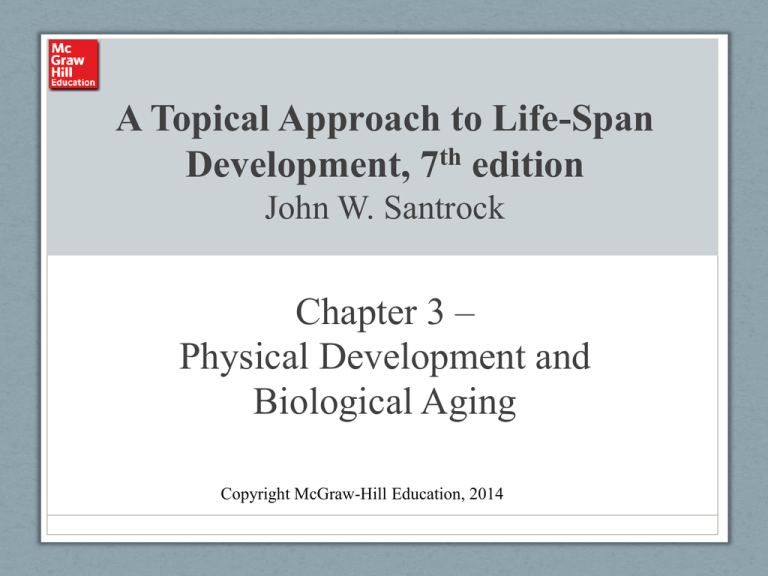Chapter 3 Santrock
advertisement

A Topical Approach to Life-Span Development, 7th edition John W. Santrock Chapter 3 – Physical Development and Biological Aging Copyright McGraw-Hill Education, 2014 Body Growth and Change • Patterns of growth • Cephalocaudal pattern • Growth sequence that gradually works from top to bottom of the body • Proximodistal pattern • Growth sequence in which growth starts at the center of the body and moves towards the extremities Copyright McGraw-Hill Education, 2014 Body Growth and Change • Puberty • Period of rapid physical maturation involving hormonal and bodily changes that take place in early adolescence • Signs of sexual maturation • Menarche • A girl’s first menstrual period • Growth spurt • Girls’ onset of puberty between 9 to 15 years of age • Boys’ onset of puberty between 10 to 17 years of age Copyright McGraw-Hill Education, 2014 Body Growth and Change • Hormones • Powerful chemical substances secreted by endocrine glands and carried through bloodstream • Hypothalamus • Brain structure involved in eating and sexual behavior • Testosterone • Hormone associated in boys with genital development, increased height, deepening voice • Estradiol • Hormone associated in girls with breast, uterine, and skeletal development Copyright McGraw-Hill Education, 2014 Body Growth and Change • Body image • Adolescents are preoccupied with their bodies • Body dissatisfaction is more acute during puberty than late adolescence • Gender differences • Girls tend to be less happy with their bodies and have more negative body image than boys • Boys become more satisfied with their bodies as they move through puberty Copyright McGraw-Hill Education, 2014 Body Growth and Change • Early and late maturation • Early-maturing boys perceived themselves more positively and had more successful peer relationships than late-maturing boys • Similar findings with girls, but not as strong • Early maturation may increase girls’ vulnerability to problems • Smoking, drinking, depression, eating disorders, struggle for independence, early dating and sexual experiences Copyright McGraw-Hill Education, 2014 Body Growth and Change • Subtle physical changes happen through early adulthood • Peak functioning of joints occurs in the twenties • Peak of muscle tone and strength in late teens and twenties • Begins to decline in thirties Copyright McGraw-Hill Education, 2014 Body Growth and Change • Middle Adulthood • Physical changes are gradual • Genetic and lifestyle factors play a role in chronic disease • Physical appearance • Lose height and gain weight • Noticeable signs of aging by forties or fifties • Strength, joints, and bones • Sarcopenia, age-related loss of lean muscle and strength Copyright McGraw-Hill Education, 2014 Body Growth and Change • Cardiovascular disease • Cholesterol levels increase through adult years • Increased risk of cardiovascular disease • Blood pressure rises • Metabolic syndrome • Condition characterized by hypertension, obesity, and insulin resistance • Leads to development of diabetes and cardiovascular disease • Lungs • Gradual change in elasticity of lung tissue after age 55 Copyright McGraw-Hill Education, 2014 Body Growth and Change • Sexuality • Climacteric • Midlife transition in which fertility declines • Menopause • Usually in late forties and fifties • Menstrual period ceases • Dramatic decline in production of estrogen Copyright McGraw-Hill Education, 2014 Body Growth and Change • Late Adulthood • Physical appearance • Midlife changes become more pronounced in late adulthood • Face wrinkles and age spots • Weight drops because of lost muscle mass • Circulatory system • Increased blood pressure, linked to heart attack, stroke, kidney disease • Drug treatment, healthy diet, exercise can reduce risk of cardiovascular disease Copyright McGraw-Hill Education, 2014 The Brain • Brain physiology • Two brain hemispheres • Cerebral cortex responsible for 80% of brain’s volume • Critical in perception, thinking, language, etc. Copyright McGraw-Hill Education, 2014 The Brain • Frontal lobes • Voluntary movement, thinking, personality, emotion, memory, attention, intentionality, or purpose • Occipital lobes • Vision • Temporal lobes • Hearing, language processing, and memory • Parietal lobes • Spatial location, attention, and motor control Copyright McGraw-Hill Education, 2014 The Brain • Myelination • Encasing of axons with a myelin sheath • Helps increase the speed and efficiency of information processing • Lateralization • Specialization of function in one hemisphere of the brain Copy The Brain • Infancy • Brain development occurs extensively during prenatal period • Infant’s head should be protected from fall or other injuries • Shaken baby syndrome can produce brain swelling and hemorrhaging • Infant’s brain is waiting for experiences to determine how neural connections are made • Children who grow up in deprived environments exhibit depressed brain activity Copyright McGraw-Hill Education, 2014 The Brain • Infant’s brain is 25% of its adult weight • During first two years of development: • Extensive myelination • Connections between neurons • Nearly twice as many connections are made than will ever be used • Blooming and pruning process begins Copyright McGraw-Hill Education, 2014 The Brain • Childhood • Brain and head grows more rapidly than any other part of body • Brain development not as rapid as in infancy • Myelination continues • Connections in the brain continue to develop • Greatest anatomical brain increases from ages 3 to 15 years; distinct bursts of growth Copyright McGraw-Hill Education, 2014 The Brain • Adolescence • Brain is still growing in adolescence • Adolescents have fewer, more selective, more effective neural connections than children • Corpus callosum • Band of fibers that connects brain’s left and right hemispheres • Thickens during adolescence, improving ability to process information • Amygdala • Brain’s center for emotions, such as anger • Matures earlier than prefrontal cortex • Capable of strong emotion but may lack self-control Copyright McGraw-Hill Education, 2014 The Brain • Adulthood and aging • Brain loses 5-10% of its weight between ages of 20 and 90 • Brain volume also decreases • General slowing of brain and spinal cord function • Begins in middle age, accelerates with age • Reduction in neurotransmitters • May play a role in memory decline • Problems in planning and carrying out motor activities Copyright McGraw-Hill Education, 2014 Sleep • Infancy • Newborns sleep 16-17 hours per day • By 6 months of age, infants have moved closer to adult-like sleep patterns • About half of infant’s sleep is REM sleep, whereas adults spend only ⅕ of the night in REM sleep • Sudden infant death syndrome (SIDS) • Childhood • Experts recommend young children get 11-13 hours of sleep each night Copyright McGraw-Hill Education, 2014 Sleep • Many adolescents exhibit inadequate sleep patterns • Less than 8 hours a day • Linked to fatigue, moodiness, depression, more caffeine beverage use, falling asleep in school • Average American adult gets just under 6 hours of sleep per night • Work and school pressures, family and social obligations lead to long hours of wakefulness and irregular sleep/wake schedules • Beginning in forties, wakeful periods during the night become more frequent • Shorter periods of deep sleep • Older adults go to bed earlier and wake earlier in morning • Approximately 50% of older adults complain of difficulty sleeping • Lack of sleep linked to health problems Copyright McGraw-Hill Education, 2014 Longevity • Average life expectancy in United States is 77.9 years • Varies for men and women and ethnic groups • Women live longer than men, but men live better. Copyright McGraw-Hill Education, 2014








